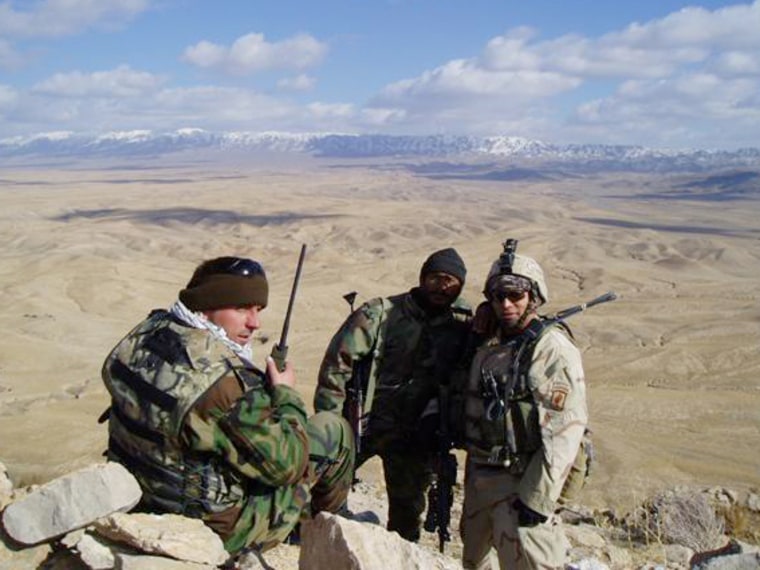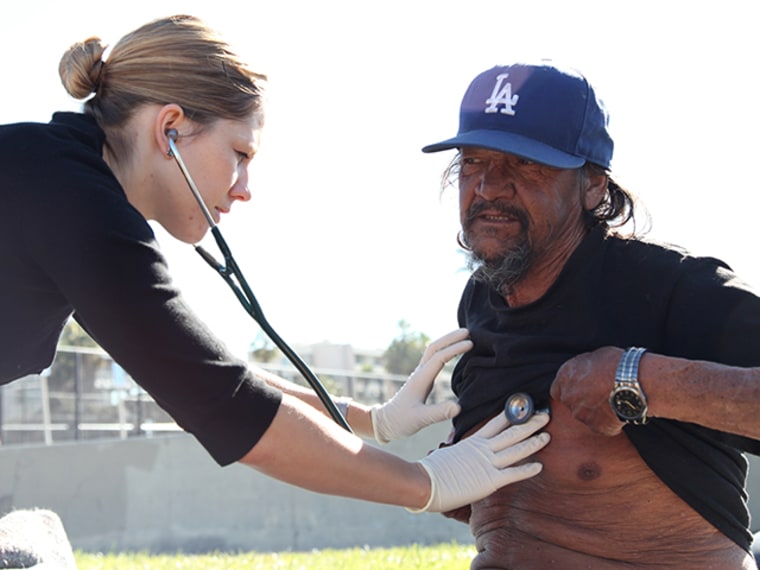Editor's note: This story is part of NBC's series "Quest for Care" exploring the shortage of health care providers as the Affordable Care Act rolls out.
Ben Olmedo traveled from Afghanistan to Alaska to find the gaps he wanted to fill. Wisconsin-born Carrie Kowalski found her niche in Venice Beach, Calif. And Vicki Chan-Padgett found her space full of needy women and children in Las Vegas 30 years after she first trained as an Air Force medic.
The three physician assistants are already helping to fill the many holes in the U.S. health care system, providing tests, counseling and other basic care when a doctor is unavailable. They expect to get busier as health care reform starts making it easier for people to pay for medical care.
The three are deployed at the very edges of the U.S. health care system, where it’s already hard to find physicians. Groups such as the Association of American Medical Colleges project a shortage of 90,000 medical doctors by 2020 as the population increases and ages -- and as more people gain the ability to pay for treatment through new insurance marketplaces and expanded Medicaid programs.
Physician assistants – trained in medicine and able to provide care with minimal supervision by a physician – are already seeking expanded roles to help fill the gap.
“Some of our patients wait six months or more to get specialist care,” says Kowalski, who just graduated from her physician assistant program at the University of Southern California in May. The Venice Family Clinic sends Kowalski in a van to scour the streets of the southern California city, finding the homeless and near-homeless who need help.
Kowalski and her team provide basic care, tending to injuries, testing and counseling for HIV, and trying to persuade patients to come in for more comprehensive care. As the changes mandated by the 2010 Affordable Care Act take hold, Kowalski expects her job to get busier because California has embraced Obamacare wholeheartedly, expanding its Medicaid program and setting up its own exchanges where people can buy health insurance.
“It really will be remarkable the impact the Affordable Care Act will have on our clients, because a lot of them so far haven’t qualified for Medicaid because they are single,” Kowalski says.
“So a great majority of them will now be able to get Medicaid, which will help us a lot -- not only because the family clinic where I work will be paid to see these patients that we already seeing, but we’ll be able to get them to the specialists they need.”
According to the American Academy of Physician Assistants (AAPA), the number of PAs has grown by a third since 2006. More than 7,000 newly accredited physician assistants graduate each year and go on to write prescriptions, manage patients with both immediate needs such as injuries and chronic disease such as diabetes, perform minor surgery and coordinate care.
“Currently, there are more than 93,000 PAs throughout the U.S. whose education in general medicine prepares them to be extremely nimble, positioning them very well to address an influx of 20 million new patients entering the health care system,” said Lawrence Herman, president of the AAPA.

As Kowalski travels the streets of sunny southern California, Olmedo makes his way through breathtaking mountain scenery near Chickaloon, northwest of Anchorage, Alaska. “I can’t complain about my commute,” says Olmedo, whose clients are Alaska natives who live 45 minutes by road from the nearest hospital.
Olmedo’s clinic patches together funding from Medicaid, federal grants and the Indian Health Service, part of the U.S. Department of Health and Human Services.
He’s among the 37 percent of PAs working in medically under-served counties.
“They could not afford to hire me if I were a physician,” Olmedo says. Not, he adds, that the pay is bad or that he provides lower-quality care. “I have got 2,000 clinical hours of training. I can do 80 percent of what a physician can do,” Olmedo says. And he can always consult with his supervising physician, and slot his patients into the hospital or to see the physician with little or no wait time.
All 50 states and the District of Columbia allow physician assistants to practice and prescribe medicine.
Chan-Padgett says it’s a mistake to classify a physician assistant as something not quite as “good” as a doctor. “You have a lot of physician-assistant students who are very, very smart who could probably get into medical school, but they prefer the life of a physician assistant,” says Chan-Padgett, who directs physician assistant studies at Touro University Nevada.
One day she may help a woman with six children; the next she may help a victim of elder abuse. “I just saw a woman last week who was locked up in her bedroom by her daughter and her daughter’s boyfriend,” said Chan-Padgett. “They were taking her Social Security checks and cashing them. When she came to the shelter she weighed 106 pounds.”
“Physician assistants have more of an ability to give back to the community.”
Olmedo agrees. “Most of the time in health care, you see a patient and they leave and you never know what happens,” he says. “Here, you do know what happens, and you can follow up and advocate for them.”
Kowalski also sees herself as an advocate. “Patients need more than just medical care. They need support. Primary care providers in this country in general are undervalued and underpaid,” she says.
“You have to be a special sort of person to work at a clinic like this,” adds Chan-Padgett, who volunteers at the Shade Tree, the only shelter for abused women and children in Las Vegas. “We don’t do anything fancy,” she says. They provide basic blood tests for cholesterol or diabetes and immediate first aid. “If they need anything more elaborate, we just can’t afford that,” she said. “The women know that. We only have (a budget of) $30,000 a year.”
Two physician assistants and two nurse-practitioners, all from a rota of volunteers, staff the clinic two days a week. “We have a pediatrician who comes in a half day a week,” Chan-Padgett adds. The clinic cut its hours back this week due to the federal budget shutdown, which has affected the flow of money from grants.
Olmedo, Kowalski and Chan-Padgett agree that it was the appeal of working intimately with people who really needed their care that brought them to the profession.
It was a big change for Olmedo, who served in both Iraq and Afghanistan.
“I was an artillery guy,” says Olmedo, who went straight from the Army into physician assistant training at Yale in 2011 and settled on a post in Alaska with his wife after looking at several possibilities, including a Navajo reservation in Arizona. “I guess a lot of it has to do with reading Jack London,” he said.
· Follow NBCNewsHealth on Facebook and on Twitter
· Follow Maggie Fox on Facebook and on Twitter
